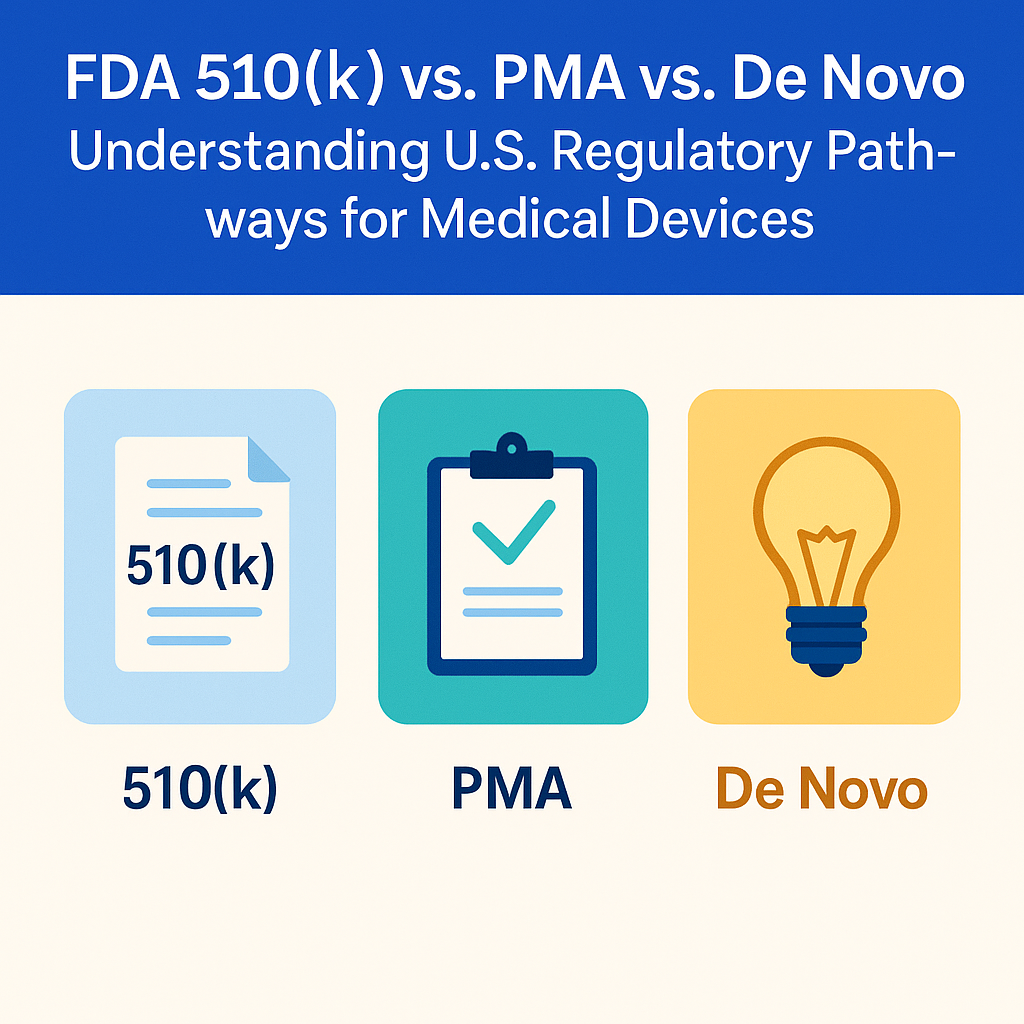
Introduction
If you’re developing a medical device for the U.S. market, one of the first and most important regulatory questions is
“Which FDA approval pathway applies to my device?”
The United States Food and Drug Administration (FDA) oversees medical devices in the Center for Devices and Radiological Health (CDRH). The FDA categorizes devices based on risk and newness, determining the FDA pathway you will follow to legally market your device in the U.S.
Here in this article, we will walk you through the three primary FDA premarket pathways:
510(k) Premarket Notification
Premarket Approval (PMA)
De Novo Classification Request
We’ll walk through each path, including when to use it, what documentation is needed, and how to choose the right one for your product.
Understanding Risk Classes
U.S. medical devices are classified into three risk-based classes:
| Class | Risk Level | Example Devices |
| Class I | Low risk | Elastic bandages, tongue depressors |
| Class II | Moderate risk | Blood pressure cuffs, infusion pumps |
| Class III | High risk | Implantable pacemakers, heart valves |
Class I devices are generally exempt from premarket submission.
Class II and III devices require premarket submissions through 510(k), PMA, or De Novo.
1️⃣ 510(k) – Premarket Notification
What Is It?
A 510(k) is an FDA submission demonstrating that your device is substantially equivalent to a legally marketed device (a predicate device) already exists. This is the most widely used path.
✅ When Is It Applicable?
Your device is Class II (or a few Class I).
There is a predicate device on the U.S. market.
Your device shares the same intended use and similar technological features.
What is in a 510(k)?
Device description
Predicate comparison table and rationale
Bench and/or animal testing
Biocompatibility and sterilization data (if required)
Electrical safety (IEC 60601), EMC, software validation
Labeling and Instructions for Use (IFU)
Sterilization validation and shelf-life testing
Software documentation (based on FDA level of concern)
⏱️ Review Timeline
Typically 90 calendar days, but longer depending on the complexity of the review or the number of AI requests.
Cost:
FDA Standard Fee (2025 est.): ~$25,000
Small Business Fee: ~$6,000–$7,000
✅ Advantages
Faster than PMA or De Novo
Less expensive
Less clinical data is required.
Established process
❌ Disadvantages
Must find a suitable predicate
Less flexibility for innovation
Limited to certain types of devices
2️⃣ PMA – Premarket Approval
What Is It?
The PMA process is the most rigorous FDA submission pathway. It is reserved for Class III devices that sustain or support life, prevent severe health impairment, or have a potentially unreasonable risk of illness or injury.
✅ When Is It Used?
No predicate exists
Your device is Class III (e.g., implantables, cardiovascular devices)
The device involves new technology or materials.
Substantial clinical evidence is to be submitted to establish safety and effectiveness.
What Does a PMA Contain?
Clinical trial data (IDE required upfront)
Design and manufacturing data
Bench and in vivo testing
Detailed labeling and instructions
Risk analysis and human factors assessment
Environmental and biocompatibility reports
PMA modules (modular design permitted)
⏱️ Review Timeline:
Standard review: ~180–320 days
Panel review (if required): longer
Supplements and amendments cause the process to drag on.
Cost:
FDA Standard Fee (2025 est.): ~$480,000
Small Business Fee: ~$120,000
✅ Pros
Opens up the market for high-tech and life-saving innovation
Creates strong regulatory trust with investors and clinicians
❌ Cons
High cost and long lead times
Clinical trials were often needed.
Greater risk of rejection without tangible proof
3️⃣ De Novo Classification Request
What Is It?
The De Novo pathway is for novel low-to-moderate risk devices with no legally marketed predicate and, therefore, are not 510(k) exempt. It provides a means to create a new classification and regulation for said device type.
✅ When Is It Applicable?
Device of low or moderate risk
There is no predicate device.
PMA-level review is not justified by risk.
???? Two Ways to De Novo
Post-510(k) Denial
Resubmit a De Novo after the “Not Substantially Equivalent (NSE)” decision.
Direct De Novo Submission
Skip 510(k) and submit De Novo directly if no predicate exists.
???? What Does a De Novo Submission Involve?
Device description and intended use
Risk/benefit analysis
Proposed classification and special controls
Testing (bench, biocompatibility, clinical if required)
Labeling, software, cybersecurity (if required)
⏱️ Review Timeline:
Average range: 150–300 days
???? Cost:
FDA Standard Fee (2025 est.): ~$130,000
Small Business Fee: ~$32,000
✅ Pros
Permits innovative technologies to reach the market
Creates new product class that others can later adopt through 510(k)
Less data-intensive and cheaper than PMA
❌ Cons
Still needs solid documentation
Review timelines can be inconsistent.
Not suitable for devices with high-risk
Head-to-Head Comparison
| Feature | 510(k) | PMA | De Novo |
| Predicate Required | ✅ Yes | ❌ No | ❌ No |
| Risk Class | Class II | Class III | Class I/II |
| Clinical Data Required | Rarely | Always | Sometimes |
| Review Time | ~90 days | 180–320+ days | 150–300 days |
| FDA Fee (2025 est.) | ~$25k | ~$480k | ~$130k |
| Innovation Support | Limited | High | Moderate |
| New Classification Created? | ❌ No | ❌ No | ✅ Yes |
| Complexity | Medium | High | Medium-High |
Examples of Real-World Devices
| Device | Pathway | Reason |
| Blood glucose meter | 510(k) | Predicate available, moderate risk |
| Implantable cardioverter-defibrillator (ICD) | PMA | Class III, life-sustaining |
| AI-based diagnostic tool for rare eye disease | De Novo | Novel tech, no predicate, moderate risk |
| Dental x-ray sensor | 510(k) | Common device, known predicate |
| Remote patient monitoring platform | De Novo | Software-heavy, no prior devices |
Choosing the Right Pathway: 5 Key Questions
What is the device’s intended use and risk classification?
Is there a predicate device on the U.S. market?
Does the tech contain new materials, design, or software?
What kind of clinical data is available or needed?
Can the device be grouped under an existing regulation or not?
Final Thoughts
The right FDA regulatory pathway is key to your medical device’s success in the U.S. market. Getting it wrong delays time to market by months or years and costs thousands in rework.
Use 510(k) when there’s a solid predicate and moderate risk.
Use PMA when you’re innovating in high-risk territory. Use De Novo when offering new solutions with moderate risk and no precedent
